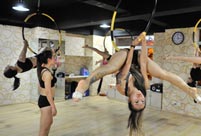

NEW YORK, March 8 (Xinhua) -- Despite its eye-catching status in the global movement to promote equal rights for women with their male counterparts, the United States as of today still has not succeeded in removing the glass ceiling for women in both the business and political arenas.
The number of female board directors in large U.S. corporations is greatly dwarfed by that of the male, according to a recent report by leading consulting firm Ernst &Young.
The report showed that only 16 percent of board seats are held by women in the S&P 1500 companies in 2014, after a gradual increase from 11 percent in 2006.
Similar situation is also observed in the Fortune 100 companies, in which only 22 percent board directors are women.
Conditions in small and medium firms are even worse, with only 12 percent and 15 percent board seats there respectively taken by women, according to the E&Y report.
In order to avoid the social awkwardness of having an all-male board, many big companies have moved to increase board size so as to add female directors, the report noted.
Women as a percentage of new board members at S&P 1500 is 23 percent in 2014, up from 18 percent in 2013.
The lack of gender parity at the executive level is more severe than that in the boardrooms, as only 4 percent of S&P 1500 companies' executive positions are held by women in 2014.
In a more vivid illustration of the gender gap in the U.S. business field, economics professor Justin Wolfers with the University of Michigan, inspired by the E&Y report, came up with an indicator that contrasts the number of women business leaders against that of male with popular names such as John.
Wolfers concluded in an article published in the New York Times that among chief executives of S&P 1500 firms, for each women, there are four men named John, Robert, William or James.
He also used the same indicator to show the permeability of the glass ceiling in the political domain.
In the article titled "Fewer women run big companies than men named John," Wolfers noted the fact that the United States, which has never had a female president, "has had six named James, five named John and four named William."
The professor found that there is a partisan divide in the so-called Glass Ceiling Index in the Congress.
"On the Republican side of the Senate, there are as many men named John as there are women. To add the Senator Roberts, Senator James and Senator Williams, they outnumber their female colleagues by a ratio of 2.17 to one. The score in the House is slightly less unbalanced, but there are still 1.36 Jims-Bobs-Jacks-Bills for every woman," Wolfers wrote.
While on the Democratic side, "women outnumber the men with these particular names by quite a margin...(but) even the index for Democratic politicians and cabinet members remains more than twice as high as the benchmark for the population as a whole," the article said.
 China hosts overseas disaster relief exercise for the first time
China hosts overseas disaster relief exercise for the first time 20 pairs of twins who will become flight attendants in Sichuan
20 pairs of twins who will become flight attendants in Sichuan J-11 fighters in air exercise
J-11 fighters in air exercise PLA soldiers operating vehicle-mounted guns in drill
PLA soldiers operating vehicle-mounted guns in drill Beauties dancing on the rings
Beauties dancing on the rings Blind carpenter in E China's Jiangxi
Blind carpenter in E China's Jiangxi Top 10 highest-paid sports teams in the world
Top 10 highest-paid sports teams in the world In photos: China's WZ-10 armed helicopters
In photos: China's WZ-10 armed helicopters UFO spotted in several places in China
UFO spotted in several places in China Obama is sowing discontent in S.China Sea
Obama is sowing discontent in S.China Sea Rescuers work through night to reach cruise ship survivors
Rescuers work through night to reach cruise ship survivors Driving through limbo
Driving through limbo Facing down MERS
Facing down MERSDay|Week